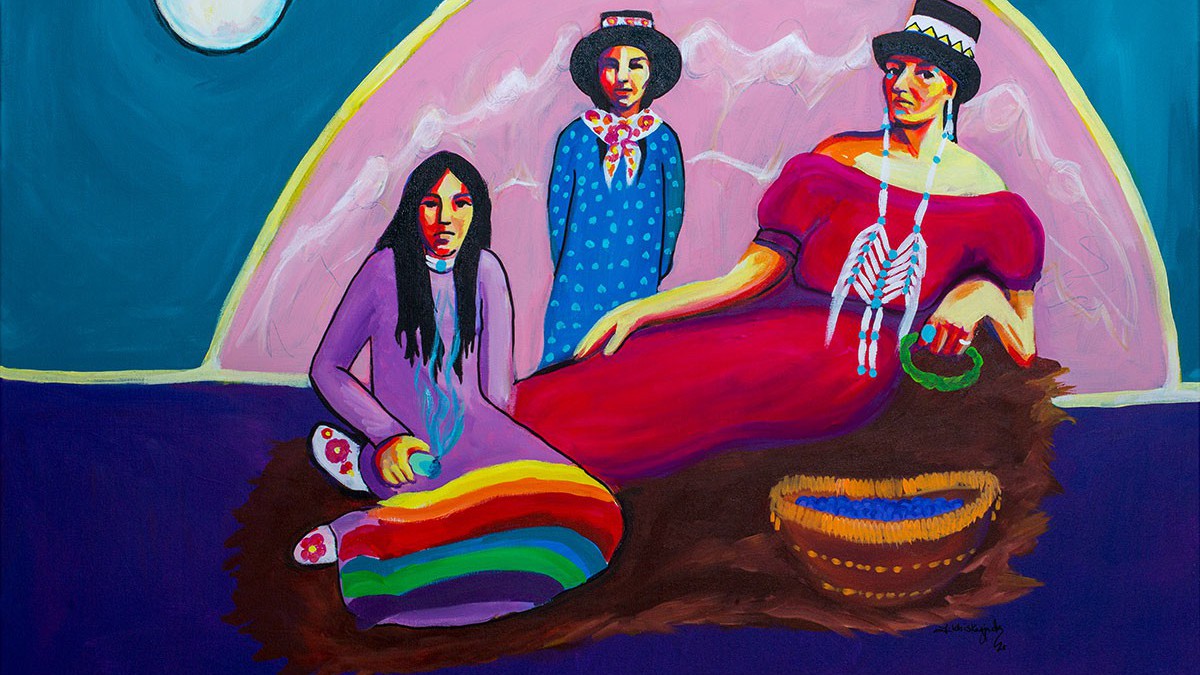To open the Land Back issue in a good way, Emily Riddle interviewed Elder Jo-Ann Saddleback about Land Back, matriarchy, democracy, and decolonization.
JS My name is Jo-Ann Saddleback. okîsikô iskwêw nitsîhkâson. I’m from the Eagle Thunderbird Clan of the Western Mountains and I am a Plains Cree woman. My father was Métis and Mohawk from the Turtle Clan. My mother was Christine Daniels, née Whiskeyjack from Saddlelake Cree Nation and it’s from her that I inherit my Clan. I am married to Jerry Saddleback. He’s from the Samson Cree Nation in Maskwacîs.
ER What would it mean for us to have our land returned to our jurisdiction? What do you think Land Back actually means?
JS That is a big question. If they were to return all the land we need to consider that what was Plains Cree territory used to be much larger, because the plains went up further, up to about where Wood Buffalo National Park is now. This is because with all the buffalo there wasn’t much bush. You couldn’t have all these trees with millions of buffalo around. So the terrain is very different. And it didn’t mean “this is my territory, don’t come here.” It meant “I have the inalienable right to project this land.” It’s based on one thing: the Creator made everything perfect. Let’s leave it that way. When explorers started coming over, they put in their journals and their logs that they had found paradise. And that’s exactly what it is. We lived to make as small a human footprint as possible. It was about being part of the environment. So to be able to go back to that, to reclaim that, to understand what that means would be Land Back.
"It’s based on one thing: the Creator made everything perfect. Let’s leave it that way."
When we’re talking about Land Back, we’re talking about menistik, the whole island, all of North, Central, and South America. And we don’t call it Turtle Island, that’s an Anishinaabe description. That’s the land that we were connected to, given to us by the Creator Himself, to be in direct kinship with. That is why we have Mother Earth, Grandmother Moon, Grandfather Sun, all those grandfathers watch over us, including the sky, the stars, all the celestial beings, all the deities that live on this Earth. We are supposed to be in direct kinship with them and to be able to relive that, to experience that. To be able to run those medicine paths, to be able to collect that earth medicine would be amazing. That medicine runs all the way to South America from here. So every year we would be going down to South America. That path is where we would collect our herbs and medicine, and we would trade along the way.
We have an expansive Cree Nation. I think it’s the largest Indigenous Nation on this continent. We have stories about how we got to have differences in the Cree Nation, why we have Plains Cree, Woodland Cree, and how that happened. At one time, all Indigenous people spoke the same language. And there is a story in our Creation Story as to why that happened. Cree is such an expansive language that there are four ways to say everything in Cree. Plains Cree have one or maybe two ways, and the Woodland Cree, they have maybe one or two ways. If we brought all of those languages together then we would know all of the Cree language. If we were to experience all the land again, we would learn that whole language. No one would not speak that lower Cree anymore. It would be that high philosophical Cree, what I call the “real Cree” because we would have the opportunity to have a more direct relationship to the land and you’d understand what it is and how you fit into it and what the Earth is giving up for us, for us to live. There is no word in our languages for survival. It is living it up with the deities! But we don’t have that opportunity anymore to have that kind of relationship. Those sacred places for us – which are the doorway to Mother Earth, where the first couple was created, at Cypress Hills – to be able to experience those sites without those borders anymore … to know where those other sacred places are … we would have the ability to be in relationship with all that we are supposed to be, to visit those places where those deities live.
"There is no word in our languages for survival. It is living it up with the deities! But we don’t have that opportunity anymore to have that kind of relationship."
The land is also how we directly connect to our nimosom tek and nokom tek (very old sacred Grandfathers and Grandmothers). It is said that nothing is lost because the prayers of our Old People are so powerful that they sit on the land, so when we do ceremony and pray, we pick up the prayers and knowledge they left for us.
All I speak of is what I believe Land Back means. Just not the language, how we will connect again to that language, what it means, and not just what we see and hear on Earth. How we are so connected to the land leads us to be connected to the universe because the very language allows us to do that.
okîsikô iskwêw nitsîhkâson.







